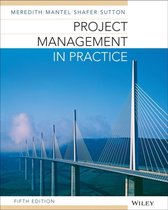Samenvatting
GIMA Module 4 Project Management - Summary Book Articles
- Instelling
- Universiteit Utrecht (UU)
Summary for Project Management exam, containing summaries of: Book "Project Management in Practice" (Chapters 1 - 8), and articles of Andersen (2016), Chin et al (2010), Conforto et al. (2016), Joslin and Muller (2015), Koskela and Howel (2002), Malotaux (2004) and Serrador and Pinto (2015).
[Meer zien]





